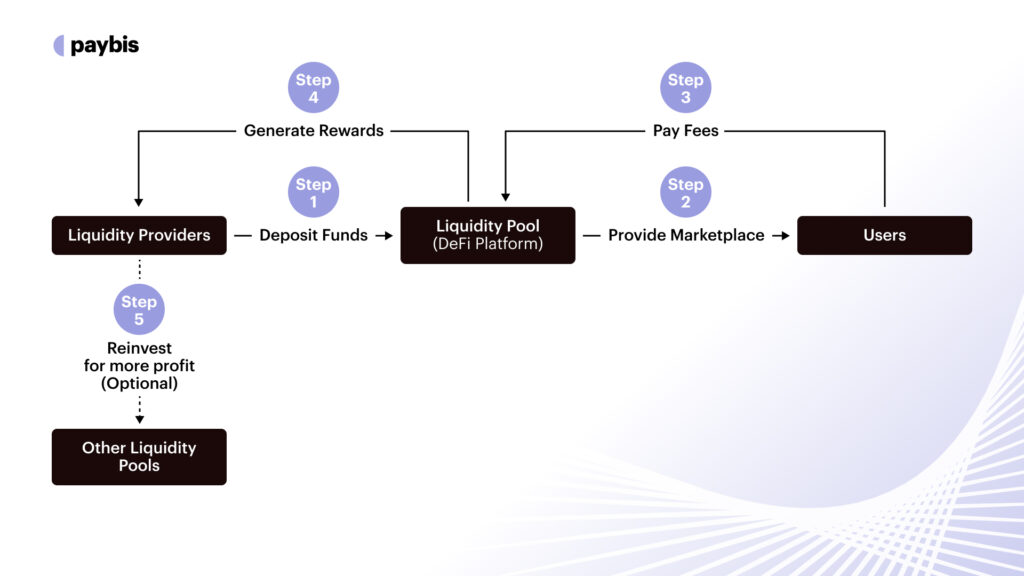Yield Farming
Yield farming is a process that allows cryptocurrency holders to earn rewards on their holdings. it involves providing liquidity to a DeFi protocol and earning returns in the form of interest or fees.
Liquidity pools have garnered immense attention from crypto enthusiasts worldwide. They are akin to gold mines, offering rich opportunities for those willing to dive head-first into the complexities of the crypto market.
The primary allure of liquidity pools lies in their ability to generate passive income. This comes in the form of transaction fees and sometimes additional rewards in the platform’s native token. For crypto enthusiasts, these pools present an opportunity to earn returns on their holdings, which is particularly appealing in a market known for its volatility. Instead of merely holding cryptocurrencies and hoping for price appreciation, users can actively engage their assets to generate a steady stream of income. Yield farming is the most common way of earning from liquidity pools (explained later).
However, it’s important to note that this opportunity is not without risk.
Table of contents
What is Yield Farming?
Yield farming is a process that allows cryptocurrency holders to earn rewards on their holdings. it involves providing liquidity to a DeFi protocol and earning returns in the form of interest or fees.

While yield farming may sound similar to staking, it involves actively providing liquidity to DeFi protocols for potentially higher rewards but with greater risks, such as market volatility and impermanent loss. In contrast, staking is a more passive, lower-risk process supporting blockchain networks.
Yield farming works primarily through liquidity providers (LPs) depositing their assets into a liquidity pool. These pools power a marketplace where users can lend, borrow, or exchange tokens. When a liquidity provider adds their tokens to a pool, they receive LP tokens or a similar form of receipt in return, which tracks their share of the pool.
The primary incentive for yield farming is the earning potential. LPs earn rewards based on the amount of liquidity they provide to the pool. These rewards come in various forms, including interest from borrowers or a portion of the transaction fees generated by the pool’s trading activity.
8 Steps to Earn from Liquidity Pools
Engaging with liquidity pools can be a rewarding venture in the DeFi space. This step-by-step guide aims to simplify the process for those interested in becoming liquidity providers (LPs) and earning from these pools.
Step 1: Choose a DeFi Platform
The first step is to select a DeFi platform that offers liquidity pools. We provided a detailed review of the top liquidity pool platforms in the next section. Each platform has its unique features, supported tokens, and fee structures, so it’s important to do some research to find the one that best suits your needs.
Step 2: Acquire Cryptocurrency
You’ll need cryptocurrency to participate in liquidity pools. Typically, pools require two tokens for deposit. Ensure you have sufficient amounts of both tokens, usually in a 1:1 ratio in terms of value. If you don’t own these tokens, you can get them through Paybis.
Step 3: Choose a Liquidity Pool
Select a liquidity pool that matches the tokens you have. Pools vary based on the token pair, risk level, and potential returns. Some pools offer higher rewards but come with greater risks, such as impermanent loss.
Step 4: Connect Your Wallet
To interact with a DeFi platform, you’ll need a digital wallet compatible with the platform, like MetaMask or Trust Wallet. Once you have your wallet set up and funded, connect it to your chosen DeFi platform.
Step 5: Add Liquidity
Once connected, you can add your tokens to the chosen liquidity pool. This process typically involves approving the transaction and confirming the addition of your tokens to the pool. Ensure you understand the transaction fees and the pool’s terms.
Step 6: Receive Liquidity Pool Tokens
Upon adding liquidity, you’ll receive LP tokens. These tokens represent your share of the pool and entitle you to a portion of the transaction fees generated by the pool. They can also be staked in some protocols for additional rewards.
Step 7: Monitor and Manage Your Investment
Stay informed about the performance of your investment. Be aware of significant price changes in the tokens you’ve deposited, as this can lead to impermanent loss. Some platforms offer tools to monitor this.
Step 8: Harvesting Rewards
You can collect your earned rewards, typically in the form of transaction fees or platform-specific tokens, according to the pool’s guidelines. This might involve staking your LP tokens or simply holding them in your wallet.
Top Liquidity Pools (Platforms) Reviewed
This section provides a review of some of the top liquidity pools in the market, highlighting their unique aspects, potential rewards, and associated risks.
These liquidity pools represent just a fraction of the options available in the DeFi space. Each comes with its own set of features, benefits, and risks. Prospective liquidity providers should consider their investment goals, risk tolerance, and the specific attributes of each pool before participating. As with any investment, diversification and up-to-date market research are key to navigating the DeFi ecosystem effectively.
Uniswap
Uniswap is one of the most prominent and widely used decentralized exchanges (DEXs) in the DeFi space. It uses an automated market maker (AMM) protocol and offers a variety of liquidity pools for different token pairs. Uniswap is known for its user-friendly interface and its governance token, UNI, which provides holders with a say in the platform’s development.
- Pros: High liquidity, wide variety of tokens, established reputation.
- Cons: Potential for high impermanent loss, especially in volatile markets.
SushiSwap
SushiSwap, a fork of Uniswap, offers similar functionality with additional features like SushiBar, where users can stake their SUSHI tokens to earn additional rewards. It also provides a wider range of tokens and incentivizes users with its own governance token, SUSHI.
- Pros: Incentive mechanisms for liquidity providers, and community governance.
- Cons: Faces competition from other AMM platforms, which can affect liquidity.
Balancer
Balancer stands out with its flexibility in allowing up to eight tokens in one pool with customizable ratios, unlike the standard 1:1 ratio in most AMM protocols. This offers more diversified portfolios and can reduce the risk of impermanent loss.
- Pros: High customization, reduced risk with diversified pools.
- Cons: Complexity can be daunting for new users.
Curve Finance
Curve Finance is optimized for stablecoin trading, offering low slippage and minimal impermanent loss. It’s ideal for those looking to trade or provide liquidity for stablecoins.
- Pros: Low slippage and impermanent loss, specialized in stablecoins.
- Cons: Limited to stablecoins and a few other assets, less attractive for those seeking diverse token exposure.
Aave
While primarily a lending platform, Aave also offers liquidity pools. Users can deposit assets to earn interest and borrow against them. Aave is known for its range of features, including flash loans.
- Pros: Multiple functionalities beyond liquidity provision, strong security track record.
- Cons: Interest rates can be variable and dependent on market conditions.
Impermanent Loss: Biggest Threat to Liquidity Providers
Impermanent loss refers to the potential loss that liquidity providers (LPs) might experience when they contribute assets to a liquidity pool, typically in a decentralized exchange (DEX). This loss is termed “impermanent” because it is not realized until the LP withdraws their assets from the pool.
Imagine you put two types of cryptocurrency, say ETH and a stablecoin like USDC, into a liquidity pool. The amount of each coin you put in is based on their current value.
Cryptocurrencies are known for their price volatility. This means the value of these coins can go up or down quite drastically. If the price of Ethereum rises or falls significantly compared to the stablecoin, this is where impermanent loss comes into play.
When the price of Ethereum changes a lot, the ratio of Ethereum to USDC in the pool changes too. The pool always tries to maintain a balance, so it adjusts the ratio automatically. This adjustment is done through a mechanism called an Automated Market Maker (AMM).
Let’s see this in action (with numbers).
An Example for Clarity
Imagine you have 1 Ethereum (ETH) and 3,000 US Dollars Coin (USDC), a stablecoin. You decide to put these into a liquidity pool. When you do this, the value of 1 ETH is equal to 3,000 USDC. So, your investment is balanced – half of it is in ETH, and half is in USDC.
Price Changes
Now, let’s say the price of ETH doubles. It’s now worth 6,000 USDC instead of 3,000 USDC.
The Pool’s Reaction
The liquidity pool you’re in always tries to maintain a balance. It does this by adjusting the amount of ETH and USDC it holds. As the price of ETH increases, the pool automatically sells some ETH for USDC to keep the value of ETH and USDC equal in the pool.
Because of this adjustment by the pool, the ratio of ETH to USDC in your share of the pool changes. Now, if you decide to withdraw your investment from the pool, you won’t get the original 1 ETH and 3,000 USDC back. Instead, you’ll get more USDC and less ETH because the pool has been selling ETH for USDC.
Calculating Loss
Let’s do a simplified calculation to understand this loss:
- Initially, you had 1 ETH (worth 3,000 USDC) and 3,000 USDC. Total value = 6,000 USDC.
- After the price increase, if you hadn’t invested in the pool, you would have 1 ETH (now worth 6,000 USDC) and 3,000 USDC. Total value = 9,000 USDC.
- But because of your investment in the pool and the rebalancing, when you withdraw, you might get something like 0.7 ETH (worth 4,200 USDC) and 3,500 USDC. Total value = 7,700 USDC.
The difference between what you would have if you simply held your ETH and USDC (9,000 USDC) and what you get after withdrawing from the pool (7,700 USDC) is the impermanent loss.
The “Impermanent” Aspect
Why is it called “impermanent”?
Because this loss only becomes permanent if you decide to withdraw your funds from the pool. As long as your funds stay in the pool, there’s a chance that the prices might come back to their original state, potentially reducing or eliminating the loss.
Tools to Calculate Impermanent Loss
There are many free tools available online that let you calculate impermanent loss. You have the fill in the fields required and the tool does the rest.
Check out a few of them below:
- Impermanent loss calculator by CoinGecko
- Impermanent loss calculator by WhiteboardCrypto
- Impermanent loss calculator by daisydefi
Conclusion
Earning from liquidity pools in the DeFi space offers an exciting avenue for cryptocurrency enthusiasts to engage their assets for passive income.
While the concept of passive income is appealing, there are many inherent risks. After all, if something is too good to be true, it probably is.
That is why you must approach with a clear understanding of the risks involved, particularly the threat of impermanent loss in volatile markets. Tools and calculators are available to aid in this, but they cannot replace diligent research and a well-considered strategy.
Found this article useful? The Paybis blog has a vast repository of more such posts that aid in building wealth and crypto portfolio through education.
Disclaimer: Don’t invest unless you’re prepared to lose all the money you invest. This is a high‑risk investment and you should not expect to be protected if something goes wrong. Take 2 mins to learn more at: https://go.payb.is/FCA-Info


